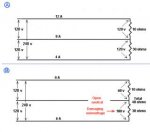ramironchis
Member
- Location
- Ecuador
Any one could help me? I need to know if there is any protection for this fault.
Thanks in advance.
Thanks in advance.
Any one could help me? I need to know if there is any protection for this fault.
Thanks in advance.
It is something that could probably be detected and the main CB tripped if it is detected.
Whether it is worth doing is something else.
I am pretty sure there are overvoltage and undervoltage relays, I know there are undervoltage ones, but sometimes the simple solution is best. Run two neutrals.
If you lose the neutral generally you will get a higher or lower voltage from hot to neutral, due to loads now in series. You could use line voltage monitors from each hot to neutral then a shunt trip breaker.
A circuit breaker, even a GFCI or AFCI breaker, will not detect a lost neutral. What it will detect is if the overvoltage on one side of the line blows up equipment which pulls enough current in the process to trip the overload function of the breaker. But IHMO that would be very unlikely.Hello, Im wondering if the CB works in the case of loss neutral, this because the CB as i see the problem going to be in serie with the circuit, do you have any experience on this.
Thanks in advance
Any one could help me? I need to know if there is any protection for this fault.
Thanks in advance.
Any one could help me? I need to know if there is any protection for this fault.
ramiron -
It would help if we could narrow this down a bit. One could fill a large library with books and papers about protective relaying, reliability of grounded systems, and Reliability Centered Maintenance.
I will start by guessing:1. The systems in question are 1 phase and residential.
2. The single phase systems are 120/240V.
If this is not so - forget the rest. But tell us what systems you are trying to protect.
First:
Are the L-O-N failures on the utility side of the main disconnect or on the house side of the main disconnect? (Answered: Line side of main - ice)
There are other failure modes that are very difficult to protect against:1. Multi-wire branch circuits losing the neutral conductor.Suggest saving these for a later discussion if you have an interest.
2. 120/240 appliances
edit to add: I'm a slow poster. Some already answered
ice
I think you need to provide much more info.
Are you asking about branch circuit, feeder or distribution work?
What voltage level?
What is the specific application?
What is the specific concern?

Say what???Great for detecting voltage problems which result from a lost neutral. But not the lost neutral itself in the absence of a load, and an unbalanced load at that.
...
Yep......
Ouch!
True, but just as a ground detector is used in an ungrounded system to immediately detect an unintended ground even though there is no fault current at that point, to be most useful a lost neutral detector should alarm when the neutral is lost, not when it starts to cause damage and the system must be shut down.Say what???
In the absence of a load, an unbalanced condition does not, cannot exist. Also, with no load, what needs protecting???
They still come together at some point.I am pretty sure there are overvoltage and undervoltage relays, I know there are undervoltage ones, but sometimes the simple solution is best. Run two neutrals.
They still come together at some point.

